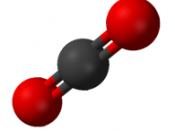Compare the Rate of Carbon Dioxide Production by Yeast under Anaerobic Conditions using different Carbohydrate Substrates.
Hypothesis.
The hypothesis that I draw is that "" out the five carbohydrate substrates that I will use, Glucose will produce the highest volume of Carbon Dioxide at every five-minute interval.
Null Hypothesis.
The null hypothesis that I am composing is that "" the five carbohydrate substrates that I am to use will not produce any Carbon Dioxide.
Scientific Research.
Under anaerobic conditions (when Oxygen is unavailable) yeast cells will break down carbohydrate substrates into ethanol and Carbon Dioxide. This is known as fermentation and is explained using the following equation: C6H12O6 2C2H5OH + 2CO2 + Energy (210kJ) The process consists of a series of reactions catalysed by specific enzymes "" that are chemicals produced by yeast cells. The enzymes produced by the yeast will only catalyse the fermentation of certain carbohydrates but not others.
Moreover, different species of yeast produce different enzymes.
Enzymes work using the enzyme-substrate complex. That is, the substrate becomes attached to the enzyme using the active site of the enzyme using the lock and key theory. This allows the substrate and the enzyme to interact in a specific way leading to a chemical reaction involving the substrate to take place and appropriate products will be formed.
Enzymes are highly specific and so they have the ability to distinguish between pairs of optical isomers (and this is important in this case). A close match between the structure of the substrates and the outline of the active site helps achieve this. However, enzymes are proteins and since proteins are not rigid, some enzymes are able to fold around their substrate after the initial binding.
The two most important substances that one must consider (in relation with this...


